
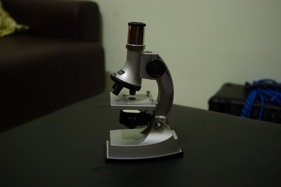
An amateur microscopist
in the tropics - or
trying to be an amateur
microscopist in Brazil.
by Leonardo S. Balbi, Rio de Janeiro, Brazil
Hello all,
My name is Leonardo Balbi, and I'm a Micscape reader
since I discovered it, some years ago, while surfing on the net.
I've always found the articles extremely useful and
well written, and have kept a desire to participate more actively
by writing something for the magazine.
In recent months this idea matured in my mind,
especially after the encouragement of Richard Howey in the last
edition, so I've decided to write something. Then came the doubt: Write
about what? Well, how about starting from the beginning?
I've had an interest in natural history since I was
very young (although, at that time, I didn't have any idea of what natural
history was), and one of my favorite trips was to visit the National Museum, one of the leading and oldest
museums of natural history of Brazil.
At the age of 12, I won a small toy microscope,
that's right, the plastic type, which today I would not recommend to
anyone, but without prior knowledge about microscopes, I thought it was
the best of all.


Fig. 1 - My first microscope
Although the images
obtained with it were not the best (plastic lenses!), I must
confess that, unlike what usually happens, despite those blurry images with no
definition, for a long time they fueled my imagination and willingness to
learn more. I still remember the endless hours spent
with the small instrument, examining each drop of standing water after
the last rain, each mound of mud and whatever else was possible to
visualize with the small instrument (which was not much!).
When it came time to choose a college subject, I chose
biological sciences, so I could always be within reach of the subjects
that interested me, and my dear microscopes.
For reasons that go far beyond what would fit into
an article like this, after graduating, I did not follow the path of my
basic training, I returned to the area of technology.
Do not complain.
Thanks to my current position at work, I enjoy
biology (more specifically microscopy) as my main hobby!
My only complaint is that: this is a rather solitary
activity in Brazil.
Acquiring my instruments
From the moment
when my finances allowed me to have a "real" microscope, I started
looking for an instrument. Of course, when we're eager to have a
microscope, we have a tendency to be less critical in our decisions (well, at least I am), and, after some research, I ended up deciding upon a Chinese
model, manufactured under the specifications of a Brazilian maker, which
was very versatile, with surprisingly good optics for an instrument
in its class.
This instrument is still with me today, being my
"tester," on which I make the changes that I do not have the courage to make on
the bigger instruments.
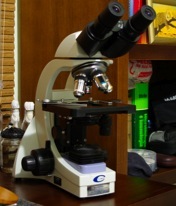
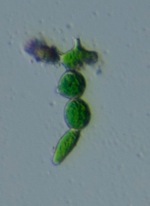
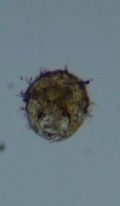
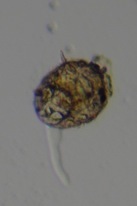
Fig. 2 - Coleman N120. Figs. 3, 4, 5 -
images obtained with the N120 - equipped with a Mathias arrow.
I was very happy
with my microscope, when one day I read in Micscape the paper by Gregor
T. Overney and Normand L. Overney about the beautiful Leitz
microscopes, finished in black enamel.
Right! I was crazed with the Ortholux and, to paraphrase
a famous Brazilian writer from the nineteen century "god free you, dear
reader, of fixed ideas". (J.M. Machado de Assis, in Memórias
Póstumas de Brás Cubas). I had to have a Ortholux!
We have here in Brazil the equivalent of e-Bay,
called "mercadolivre.com". But this, even virtually, shows the diversity
and multiplicity of what can be found on e-Bay.
A few weeks after reading the mentioned article,
rather jokingly, I searched for "Leitz Ortholux" at "mercadolivre". Since
I had never found anything similar here, only on e-Bay, I thought the
result would be, again, zero. However, on this day the search returned
one entry. A person in São Paulo (I live in Rio de Janeiro) was
selling an Ortholux, beautifully maintained, configured for transmitted
illumination in brightfield, with a Berek condenser. The only detail
of this instrument was that it did not have an original set of Leitz
objectives, but it came with a kit from Reichert (excellent by the way
- one objective, a planachro 30x with NA of 0.65 and is one of the best
I've used up today).
The best thing about this purchase however, was the
vendor. A retired biologist who, among other things also collects (I think "amass" would be the more appropriate term) microscopes. One
more for the group.
I have a secondary hobby, astronomy, and through this, I met a guy here in Rio de Janeiro, working on the maintenance of microscopes, and through him, got a set of phase contrast for the Ortholux,
a Heine condenser, with the objectives 10x Pv, 25x Pv, 40x Pv Apo and 70x
Pv Fluor, in the original box!
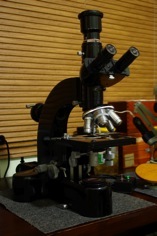
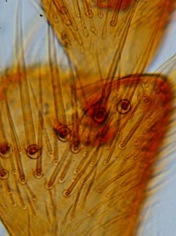
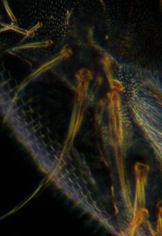
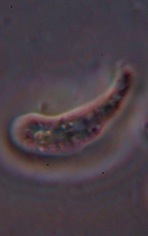
Fig. 6 - Leitz Ortholux and
accessories. Figs. 7, 8, 9 - images obtained with the Ortholux -
brightfield (Berek) - darkfield (Heine) - phase contrast (Heine).
Sometime later, I
was able to get a Zeiss Photomicroscope III, configured for brightfield
- which included an excellent set of Plan-achromatics, including a 1X. This
instrument was purchased in the U.S., via eBay, and one of the coolest
things is that it is 100% working, including the internal
35 mm camera. Recently I added a condenser for phase contrast,
however, (for now) without the corresponding phase objectives. I also want to
configure this one for interference contrast (DIC).
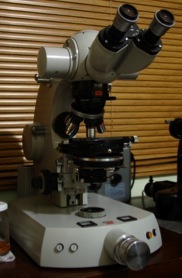
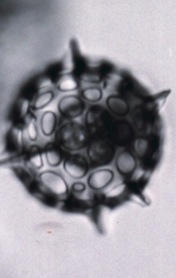
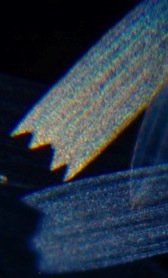
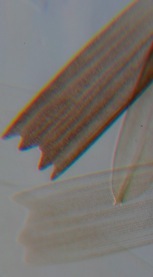
Fig. 10 - Zeiss PM III. Figs. 11, 12,
13, 14 - photos taken with the PM III - Internal 35mm camera,
brightfield, darkfield, oblique.
Despite all these
instruments I didn't have a good stereo. This omission was solved recently with the
help of my friend from São Paulo, I acquired a nice Zeiss SM XX
(Zeiss Jena) largely complete, equipped with incident lighting and
transmitted light, camera lucida (for drawings), photographic
accessories and polarization (transmitted - that's right!!).
I will not dwell much on this instrument, as I intend to do a review of
it in an upcoming edition. I do include here some photos.

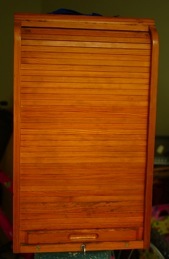
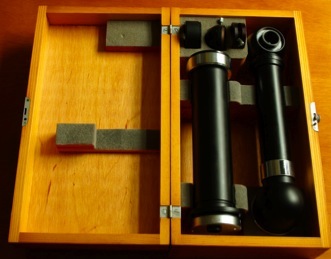
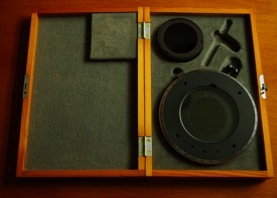
Fig. 15 - Zeiss Jena SM XX. Figs. 16,
17, 18 - SM XX accessories - original box, camera/drawing kit,
polarization set.
Well, I guess I
could describe a little about who I am, and my basic setup. I will try
to show what I do and find with this equipment in future editions. I
think that's all.
If anyone from Brazil reads this magazine, please
contact me. If you don't live in Brazil, contact me anyway!!
Questions, comments and suggestions are always welcome.
Best wishes to all,
Leonardo S. Balbi
Microscopy UK Front
Page
Micscape
Magazine
Article
Library
Published in the October 2010 edition of Micscape Magazine.
Please report any Web problems or offer general comments to the Micscape Editor .
Micscape is the on-line monthly magazine of the Microscopy UK website at Microscopy-UK .
© Onview.net Ltd, Microscopy-UK, and all contributors 1995 onwards. All rights reserved. Main site is at www.microscopy-uk.org.uk with full mirror at www.microscopy-uk.net .